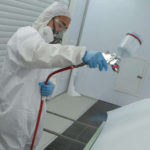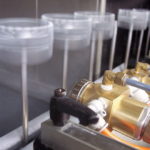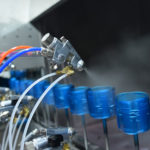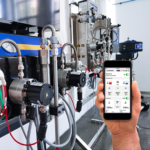As the name implies, water base paints are water-based. For example, all our paints such as metal paint and car paint etc. all have corresponding water-based paint products. It has been widely used in various industries. Water base paint is the development direction of the future paint market. The demand of safe production from enterprises, the improvement of employees’ safety awareness and labor costs, the focus of coating enterprises on water-based paints have contributed to the irreversible development of water base paints.
Instruction Manual
Water base paints have excellent non-stickiness and durability, but the construction steps are very strict, so we must fully read and understood when using.
First, the pretreatment of product: product(aluminum or stainless steel) with (360°C × 30 minutes ~ 380°C × 10 minutes) burning or solvent cleaning for the first step degreasing, the second step is surface roughening using corundum Sand 80#~100#, pressure 0.4~0.6mpa, thickness of sand: (2.0~3.5)μm
Second: primer coating: the primer paint must be fully rolled 120 rpm before use, not less than 2 hours / time rolling, not less than once a week. Then load pretreated product(must be clean, dry, without any grease , pollution, it is strictly forbidden to touch the sand surface by hand, otherwise it will seriously affect the adhesion, and even lead to peeling) , use Ф1.0~1.5mm nozzle spray gun with air pressure 0.2~0.3mpa and distance 20~30cm for direct spraying. After that, flash off under 120-150°C × 5-8 minutes, the coating thickness after surface drying is 10~15 μm
Last: top coatings μm: top layer coating must also be rolled at a slow speed of 100 rpm/min, 3 hours/time, and must be thoroughly mixed evenly. After cooling the workpiece with primer to room temperature, we can apply top coating (the surface should be absolutely clean and not contaminated). Use a spray nozzle of Ф1.0~1.5mm, adjust air pressure to 0.2~0.3mpa, distance 20~30cm then spraying. Once done, flash off under 120°C×5 minutes then curing at 380°C for 30 minutes, and the total coating film after sintering was 20 to 23μm. (Insufficient sintering will reduce adhesion and the coating physical properties. Excessive sintering will make the coating performance worse, so please be careful.)
Operational skills
Tip 1: Use clean water to prepare paint viscosity to a suitable condition, measure with #4 viscometer. The appropriate viscosity is typically 20 to 30 seconds. If there is no viscometer, visual method can be used: stir the paint with a rod (iron rod or wooden stick) and pick it up to a height of 20 cm to stop and observe. If the paint liquid is continuous in short period(several seconds), it means too thick; if it is cut off the edge of the drum, it means too thin; when it is just 20cm high, the paint liquid is in a straight line, and the instantaneous flow is turned into a downward drop. This viscosity is suitable for spraying.
Tip 2: The air pressure is best controlled at 0.3-0.4 MPa (3-4 kgf/cm2). If the pressure is too small, the liquid of the paint will be poorly atomized, and the surface will form pitting. If the pressure is too large, it will sag and the paint mist will be too large, which will waste paint materials and affect operator health.
Tip 3: The distance between spray nozzle and object surface is generally 300-400 mm. It is easy to sag if too close; the paint mist is not uniform if too far. If the nozzle is far away from the object surface, paint fog is scattered on the way. The specific distance should be adjusted according to the type of paint, viscosity and pressure. Slow-drying paint spraying distance can be a little farther, quick-drying paint spraying, the distance can be closer; when the viscosity is thick, it can be closer, when the viscosity is thin, the distance can be farther; when the air pressure is large, the distance can be farther, when pressure is low, the pressure can be closer; the so-called “a little closer” or “a little farther” is small adjustment between 10 mm and 50 mm. If it exceeds this range, it is difficult to obtain a desired paint film.
Tip 4: The spray gun can be moved up and down, left and right, preferably at a speed of 10-12 m / min. The nozzle should be sprayed straight to the surface to minimize the oblique spray. When spraying to both ends of the object, spray gun trigger should be closed quickly to reduce paint fog, because the two ends often need to be sprayed twice or more, which is the most likely place for sag.
Tip 5: When spraying, the next track need to cover 1/3 or 1/4 of the previous one, so that there will be no leakage. When spraying the quick-drying paint, it is necessary to spray it in sequence. The effect of refilling is not ideal.
Tip 6: When spraying in an open space, pay attention to the wind direction (not suitable for operation in high winds). The operator should stand in the downwind direction to prevent paint mist from being blown onto the sprayed paint film to create an unsightly grainy surface.
Tip 7: The order of spraying is: difficult first then easy, first inside then outside. upside first then down side, small area firs then big. This will not cause the spray mist of the post-spray to splash onto the sprayed paint film and destroy the sprayed paint film.
The key issue
Although water-based paints are healthy and environment friendly, there are two key issues to be aware of.
First, transportation, storage, attention to antifreeze: water-based paint contains about 20-50% of water, water-based paint will often freeze when temperature is lower than 0°C
Second, pay attention to anti-corrosion and mildew: in water-based paint, there are both water and bacteria, which can be easily contaminated. Therefore, in order to prevent deterioration, it is necessary to add antiseptic and antifungal agent.
Also, since water base paint is not friendly to regular steel, so when programming your spray paint machine or coating line system, we should use stainless steel as much as possible when there’s contact with paint. For example the fixture and spray booth. Under some high standard construction, the coating line system moving guide and even conveyor chain are all required for stainless steel.




